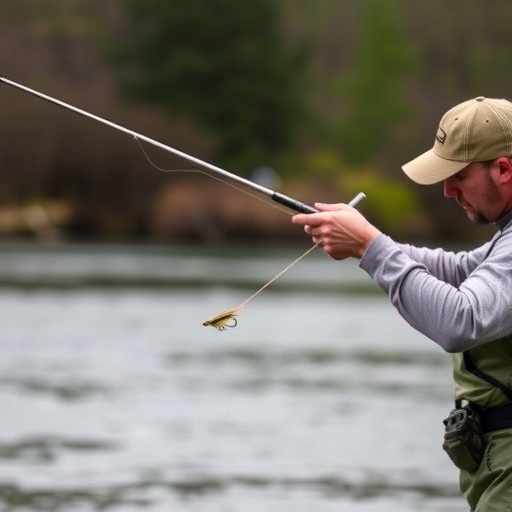In a groundbreaking advancement within the realm of sports engineering, researchers have unveiled an innovative simulation model for fly casting, aimed at enhancing overhead casting techniques. The study, spearheaded by a team of experts including H. Ekander, N.C. Perkins, and B.W. Richards, meticulously dissects the complexities of fly casting, an art revered not merely as a technique, but as a skill that intertwines physics with the finesse of angling. This research marks a significant departure from conventional training methods, proposing a technologically advanced approach that simulates real-world casting conditions to optimize performance.
A fundamental aspect of this research is the intricate understanding of the mechanics governing fly casting. Fly casting is not just about the throw; it encompasses the angle of release, the tension of the line, and the delicate balance between force and finesse. By leveraging physics and computer simulations, the researchers are able to model these mechanics, providing a platform for both novice and seasoned anglers to refine their skills. This approach not only democratizes access to high-level training but also opens new avenues for competitive fishing techniques.
The simulation model developed in this study allows users to visualize the casting motion, offering a unique opportunity to dissect each component of the cast. This tool can help casters understand the impact of various elements such as the weight of the fly, the type of rod, and even environmental factors like wind resistance. By creating an interactive interface, the researchers encourage a hands-on learning experience where users can experiment with different scenarios and observe the outcomes in real-time. This experimentation phase is crucial for developing a deeper intuitive understanding of the casting process.
One of the standout features of this simulation model is its capacity to analyze the kinematics of the cast. The researchers have employed advanced algorithms to simulate the trajectory of the fly line, enabling users to visualize how subtle changes in technique can influence the casting distance and accuracy. This aspect of the model is particularly beneficial for those looking to transition from recreational casting to more competitive levels, where precision is paramount.
Moreover, the research delves into the biomechanical aspects of casting, examining how body posture and movement contribute to an effective overhead cast. Anglers often strive for a fluidity that harmonizes their body mechanics with the demands of casting. The simulation model assists users in recognizing the optimal body movements that can lead to improved performance, effectively marrying the scientific understanding of biomechanics with the practical application of casting techniques.
As the study progresses, the integration of feedback mechanisms within the simulation model stands out as another innovative aspect. Using real-time data, the model can provide personalized feedback to users, allowing them to identify their weaknesses and strengths during practice sessions. This immediate feedback loop not only accelerates the learning curve but also builds confidence among anglers as they witness tangible improvements over time.
Additionally, the research team’s findings suggest that this model can benefit not just individual casters, but also instructors and coaches. By incorporating the simulation into their training regimens, coaches can tailor their strategies to better meet the needs of their students, ensuring a more customized learning experience. This collaborative aspect of the model bridges the gap between technology, education, and the sport of fly casting, ultimately fostering a community of informed and skilled anglers.
Another noteworthy highlight of this study is its potential implications for the future of fishing competitions. As tournaments become increasingly competitive, the science behind casting can give participants a distinct advantage. Understanding the physics of casting and being able to simulate different scenarios can set elite anglers apart from the rest. The team’s approach emphasizes not just the importance of skill but also the necessity of constant adaptation to achieve excellence in a sport that is steeped in tradition yet ripe for innovation.
Furthermore, the implications of this research extend beyond the boundaries of fly casting, potentially influencing other areas within sports engineering. The principles underlying the simulation model are transferable to various fields where precision motion and technique play critical roles. Future research could explore how these simulations can aid in other athletic endeavors, creating a ripple effect that innovates training practices across multiple sports disciplines.
As the study progresses toward publication in the journal Sports Engineering, anticipation builds within the sporting community regarding the practical applications of this research. The authors have expressed a commitment not only to advancing fly casting techniques but also to contributing to the broader field of sports engineering by sharing their findings with fellow researchers and practitioners.
In conclusion, the development of this simulation model for fly casting is an exemplary showcase of how technology can reshape traditional practices. By offering an immersive, interactive platform that analyzes both the mechanical and biomechanical elements of casting, the research team positions this model as an essential tool for anyone looking to elevate their fly casting prowess. As the sport continues to evolve, the intersection of engineering and angling promises to unlock new possibilities, enabling all anglers to cast with confidence and precision.
Subject of Research: Development of a simulation model for fly casting and application to overhead casting
Article Title: Development of a simulation model for fly casting and application to overhead casting
Article References:
Ekander, H., Perkins, N.C. & Richards, B.W. Development of a simulation model for fly casting and application to overhead casting.
Sports Eng 28, 2 (2025). https://doi.org/10.1007/s12283-024-00482-4
Image Credits: AI Generated
DOI: 10.1007/s12283-024-00482-4
Keywords: Fly casting, simulation model, overhead casting, sports engineering, biomechanics.




